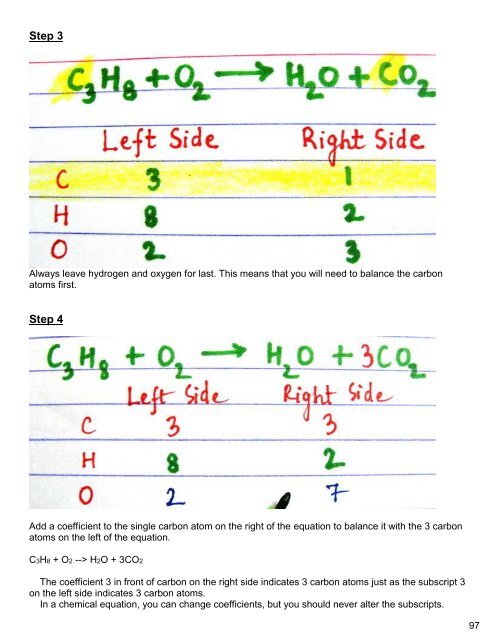Create successful ePaper yourself
Turn your PDF publications into a flip-book with our unique Google optimized e-Paper software.
Example: Converting between mass and moles<br />
Knowing a substance’s molar mass is useful, because the molar mass acts as a conversion factor<br />
between the mass of a sample and the number of moles in that sample (Equation 1). For converting<br />
between the number of moles in a sample and the number of molecules in the sample, Avogadro’s<br />
number acts as the conversion factor, as shown in Equation 2 below.<br />
Equation 1<br />
Sample mass (g) = Moles in sample (mol)<br />
Sample's molar mass (g/mol)<br />
Equation 2<br />
Moles in sample (mol) x Avogadro's number (number/mol) = Number of sample molecules<br />
To understand how molar mass and Avogadro’s number act as conversion factors, we can turn to an<br />
example using a popular drink: How many CO2 molecules are in a standard bottle of carbonated<br />
soda?<br />
Thanks to molar mass and Avogadro’s number, figuring this out doesn’t require counting each<br />
individual CO2 molecule! Instead, we can start by determining the mass of CO2 in this sample. In an<br />
experiment, a scientist compared the mass of a standard 16-ounce (454 milliliters) bottle of soda<br />
before it was opened, and then after it had been shaken and left open so that the CO2 fizzed out of<br />
the liquid. The difference between the masses was 2.2 grams—the sample mass of CO2 (for this<br />
example, we’re going to assume that all the CO2 has fizzled out). Before we can calculate the number<br />
of CO2 molecules in 2.2 grams, we first have to calculate the number of moles in 2.2 grams of CO2<br />
using molar mass as the conversion factor (see Equation 1 above):<br />
Equation 3<br />
Now that we’ve figured out that there are 0.050 moles in 2.2 grams of CO2, we can use Avogadro’s<br />
number to calculate the number of CO2 molecules (see Equation 2 above):<br />
Equation 4<br />
While scientists today commonly use the concept of the mole to interconvert number of particles and<br />
mass of elements and compounds, the concept started with 19th-century chemists who were puzzling<br />
out the nature of atoms, gas particles, and those particles’ relationship with gas volume.<br />
94




